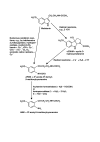Melatonin, a potent agent in antioxidative defense: actions as a natural food constituent, gastrointestinal factor, drug and prodrug
- PMID: 16153306
- PMCID: PMC1262766
- DOI: 10.1186/1743-7075-2-22
Melatonin, a potent agent in antioxidative defense: actions as a natural food constituent, gastrointestinal factor, drug and prodrug
Abstract
Melatonin, originally discovered as a hormone of the pineal gland, is also produced in other organs and represents, additionally, a normal food constituent found in yeast and plant material, which can influence the level in the circulation. Compared to the pineal, the gastrointestinal tract contains several hundred times more melatonin, which can be released into the blood in response to food intake and stimuli by nutrients, especially tryptophan. Apart from its use as a commercial food additive, supraphysiological doses have been applied in medical trials and pure preparations are well tolerated by patients. Owing to its amphiphilicity, melatonin can enter any body fluid, cell or cell compartment. Its properties as an antioxidant agent are based on several, highly diverse effects. Apart from direct radical scavenging, it plays a role in upregulation of antioxidant and downregulation of prooxidant enzymes, and damage by free radicals can be reduced by its antiexcitatory actions, and presumably by contributions to appropriate internal circadian phasing, and by its improvement of mitochondrial metabolism, in terms of avoiding electron leakage and enhancing complex I and complex IV activities. Melatonin was shown to potentiate effects of other antioxidants, such as ascorbate and Trolox. Under physiological conditions, direct radical scavenging may only contribute to a minor extent to overall radical detoxification, although melatonin can eliminate several of them in scavenger cascades and potentiates the efficacy of antioxidant vitamins. Melatonin oxidation seems rather important for the production of other biologically active metabolites such as N1-acetyl-N2-formyl-5-methoxykynuramine (AFMK) and N1-acetyl-5-methoxykynuramine (AMK), which have been shown to also dispose of protective properties. Thus, melatonin may be regarded as a prodrug, too. AMK interacts with reactive oxygen and nitrogen species, conveys protection to mitochondria, inhibits and downregulates cyclooxygenase 2.
Figures



Similar articles
-
Antioxidative protection by melatonin: multiplicity of mechanisms from radical detoxification to radical avoidance.Endocrine. 2005 Jul;27(2):119-30. doi: 10.1385/endo:27:2:119. Endocrine. 2005. PMID: 16217125 Review.
-
Anti-inflammatory actions of melatonin and its metabolites, N1-acetyl-N2-formyl-5-methoxykynuramine (AFMK) and N1-acetyl-5-methoxykynuramine (AMK), in macrophages.J Neuroimmunol. 2005 Aug;165(1-2):139-49. doi: 10.1016/j.jneuroim.2005.05.002. J Neuroimmunol. 2005. PMID: 15975667
-
Antioxidant properties of the melatonin metabolite N1-acetyl-5-methoxykynuramine (AMK): scavenging of free radicals and prevention of protein destruction.Redox Rep. 2003;8(4):205-13. doi: 10.1179/135100003225002709. Redox Rep. 2003. PMID: 14599344
-
On the free radical scavenging activities of melatonin's metabolites, AFMK and AMK.J Pineal Res. 2013 Apr;54(3):245-57. doi: 10.1111/jpi.12010. Epub 2012 Sep 23. J Pineal Res. 2013. PMID: 22998574 Review.
-
Significance of melatonin in antioxidative defense system: reactions and products.Biol Signals Recept. 2000 May-Aug;9(3-4):137-59. doi: 10.1159/000014635. Biol Signals Recept. 2000. PMID: 10899700 Review.
Cited by
-
Influence of Melatonin Treatment on Cellular Mechanisms of Redox Adaptation in K562 Erythroleukemic Cells.Genes (Basel). 2022 Dec 11;13(12):2337. doi: 10.3390/genes13122337. Genes (Basel). 2022. PMID: 36553603 Free PMC article.
-
New approaches in the management of insomnia: weighing the advantages of prolonged-release melatonin and synthetic melatoninergic agonists.Neuropsychiatr Dis Treat. 2009;5:341-54. doi: 10.2147/ndt.s4234. Epub 2009 Jun 10. Neuropsychiatr Dis Treat. 2009. PMID: 19557144 Free PMC article.
-
Melatonin and its agonist ramelteon in Alzheimer's disease: possible therapeutic value.Int J Alzheimers Dis. 2010 Dec 8;2011:741974. doi: 10.4061/2011/741974. Int J Alzheimers Dis. 2010. PMID: 21197086 Free PMC article.
-
Role of Melatonin in Viral, Bacterial and Parasitic Infections.Biomolecules. 2024 Mar 16;14(3):356. doi: 10.3390/biom14030356. Biomolecules. 2024. PMID: 38540774 Free PMC article. Review.
-
Melatonin: Both a Messenger of Darkness and a Participant in the Cellular Actions of Non-Visible Solar Radiation of Near Infrared Light.Biology (Basel). 2023 Jan 6;12(1):89. doi: 10.3390/biology12010089. Biology (Basel). 2023. PMID: 36671781 Free PMC article. Review.
References
LinkOut - more resources
Full Text Sources
Other Literature Sources
Research Materials

